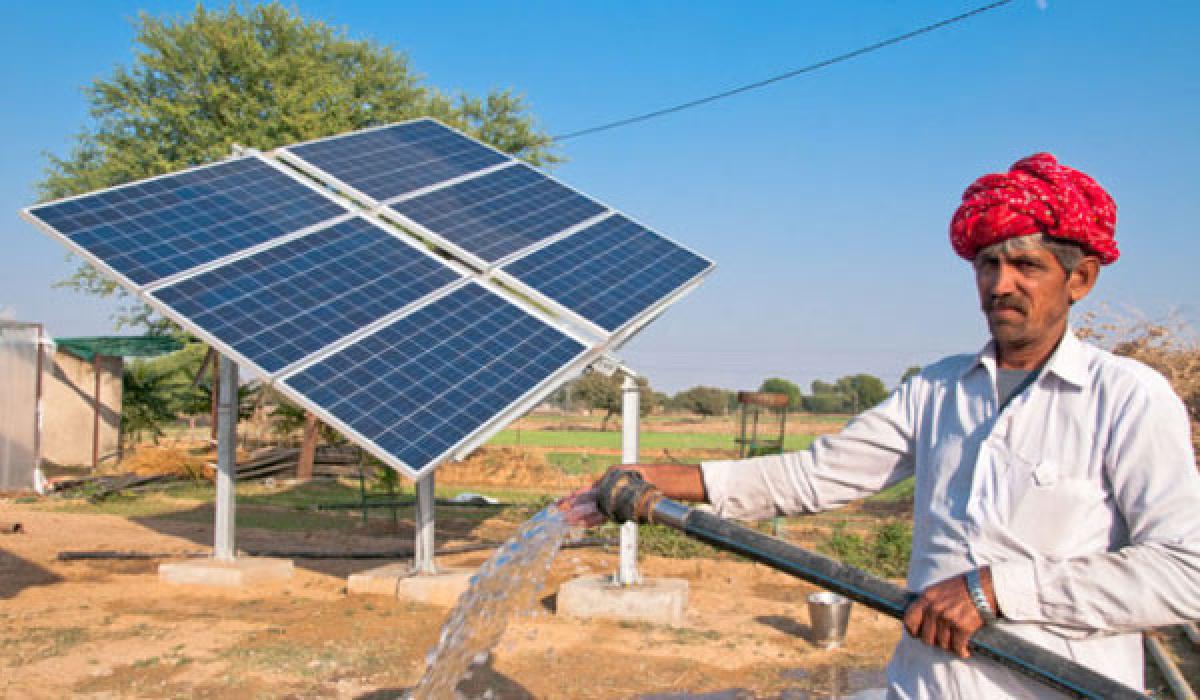Live
- Eknath Shinde compares Uddhav Thackeray's change in political stance with 'chameleon changing colours'
- Calcutta HC admits plea seeking action against Mamata Banerjee for 'anti-judiciary' remarks
- ‘NWHL provides a platform for our top women's hockey talent to show their skills’, says Bhola Nath Singh
- NCP-SP manifesto biggest fraud in the world, claims Maharashtra BJP chief
- Haryana to send wedding-style invitations to voters
- Wanted posters for missing Cong leader surface in Surat amid rumours of likely defection to BJP
- Delhi: Sharpshooter of Hashim Baba gang nabbed; Rs 50 lakh extortion plan foiled
- EC sends notice to BJP over PM Modi's speech in Banswara
- PM Modi ups ante against Congress, says Rajiv Gandhi abolished inheritance law to 'save own interests'
- Cong candidate in Kerala suspects foul play as list of poll officials leaked, one suspended
Just In

About 70% of India’s electricity generation capacity is from fossil fuels. India is largely dependent on fossil fuel imports to meet its energy demands. By 2030, India’s dependence on energy imports is expected to exceed 53% of the country’s total energy consumption. Greater import dependence is a a threat to India’s energy security as it introduces global market volatility into the mix. It also a
- About 70% of India’s electricity generation capacity is from fossil fuels. India is largely dependent on fossil fuel imports to meet its energy demands.
- By 2030, India’s dependence on energy imports is expected to exceed 53% of the country’s total energy consumption. Greater import dependence is a a threat to India’s energy security as it introduces global market volatility into the mix.
- It also adds to a huge import bill leading to a loss of valuable foreign capital. We need to shift our focus towards the renewable energy sources.
- After the recently concluded Paris talks, wherein countries agreed to limit their emissions so as to contain the global temperature rise to Co2, the need to develop renewable energy sector gains even more importance.
- There are various sources of renewable energy like wind, nuclear, solar, tidal, geothermal etc. But, in this article, we shall mainly talk about the solar energy and various policy initiatives of India in this sector.
Solar Energy
As per World Energy Outlook Report 2015, India has substantial solar potential around 750 gigawatts (GW) (based on the assumption that 3% of wasteland in each state can be used for solar power projects, plus an assessment of the potential for rooftop solar). This represents almost three times India’s total installed power capacity today.
Solar capacity region wise
The solar resource is strongest in the north and northwest of the country (Rajasthan, Jammu and Kashmir), but the potential is also considerably high in several other states, including Maharashtra, Madhya Pradesh, and Andhra Pradesh.
India’s renewable energy target
- Target: 175GW from renewable energy sources by 2022 • Break up:100 GW from solar, 60 GW from the wind, 10 GW from biomass and 5 GW from small hydroelectric projects.
- 100GW = 60 GW of utility-scale projects (both solar PV and CSP) like solar parks + 40 GW of rooftop solar applications for commercial users and households, together with some small-scale schemes and off-grid capacity
National Solar Mission or Jawaharlal Nehru National Solar Mission (JNNSM)
- It was launched on 11th January 2010 Apex ministry: Ministry of New and Renewable Energy (MNRE).
- India’s Solar capacity in 2010: 17.8MW
- Grid connected solar power in 2016: 8GW
Objectives of JNNSM
- To establish India as a global leader in solar energy
- To promote ecologically sustainable growth while addressing India’s energy security challenges
- Short term: To create enabling environment for penetration of solar technology throughout the country Mission’s target was revised in 2015,
- Initial Target: 20GW
- Target is to be achieved in 3 phases,
- 1st Phase: 2010-13
- 2nd Phase: 2013–17
- each stage, progress will be reviewed and roadmap for future targets will be adopted.
Domestic content controversy
- Guidelines for the solar mission mandated cells and modules for solar PV projects based on crystalline silicon to be manufactured in India.
- This accounts for over 60% of total system costs.
For solar thermal, guidelines mandated 30% project to have domestic content.
- A vigorous controversy emerged between power project developers and solar PV equipment manufacturers.
- The former camp prefers to source modules by accessing highly competitive global market to attain flexible pricing, better quality, predictable delivery and use of latest technologies.
- The latter camp prefers a controlled/planned environment to force developers to purchase modules from a small, albeit growing, group of module manufacturers in India.
- Manufacturers want to avoid competition with global players and are lobbying the government to incentivize growth of local industry.
- US Trade Representative has filed a complaint at World Trade Organization challenging India’s domestic content requirements citing discrimination against US exports.
- WTO ruled in favor of USA.
Road towards solar superiority
- The State of Gujarat has commissioned Asia’s largest solar park at Charanka village.
- The French group AREVA Solar is currently engaged in constructing a 250 MW concentrated solar power (CSP) installation in Rajashtan, which will become the largest CSP installation in Asia.
- The International Finance Corporation (IFC), the World Bank Group’s private sector arm, is supporting the Indian state of Madhya Pradesh set up the 750-MW ultra-mega solar power project in Rewa. This will be the largest single-site solar power project in the world
- World’s largest single rooftop solar power plant of 11.5 Mw capacity was inaugurated in Beas near Amritsar in Punjab
- Cost dropped but more research needed: The cost of solar per kilowatt hour dropped from a 2012 Planning Commission estimate of Rs. 10.4 – 12.5 to Rs. 4.3 in the latest round of “reverse auctions” (low bid wins) but still many coal based power plants are rivaling it at around Rs 3KW per hour. Thus more research is needed to bring the cost further down.
Advantages of switching to solar
Environment-friendly
- Solar energy is environment-friendly. When in use, it does not release CO2 and other gases which pollute the air. Hence it is very suitable for India, India being one of the most polluted countries of the world.
- Varied use
- Solar energy can be used for a variety of purposes like as heating, drying, cooking or electricity, which is suitable for the rural areas in India. It can also be used in cars, planes, large power boats, satellites, calculators and much more such items, just apt for the urban population.
Abundant & Secure
Solar power is inexhaustible. In energy deficient country like India, where power generation is costly, solar energy is the best alternative means of power generation.
Grid independent
- You don’t need a power or gas grid to get solar energy. A solar energy system can be installed anywhere. Solar panels can be easily placed in houses. Hence, it is quite inexpensive compared to other sources of energy
- Reduced dependence on fossil fuels Disadvantages
Not available during night time
Weather dependent
- During daytime, the weather may be cloudy or rainy, with little or no sun radiation. Hence, this makes solar energy panels less reliable as a solution.
- Sunny area required
- Only those areas that receive good amount of sunlight are suitable for producing solar energy.
High upfront cost
- Solar panels also require inverts and storage batteries to convert direct electricity to alternating electricity so as to generate electricity. While installing a solar panel is quite cheap, installing other equipment becomes expensive.
High surface area required
- The land space required to install a solar plant with solar panel is quite large and that land space remains occupied for many years altogether and cannot be used for other purposes. India is already a highly populous and land starved country.
- Energy production is quite low compared to other forms of energy.
Maintenance
- Solar panels require considerable maintenance as they are fragile and can be easily damaged. So, extra expenses are incurred as additional insurance costs.
Disadvantages of Solar Energy in India
- We cannot generate energy during the night time with solar energy.
- And, also during day time, the weather may be cloudy or rainy, with little or no sun radiation. Hence, this makes solar energy panels less reliable as a solution.
- Only those areas that receive good amount of sunlight are suitable for producing solar energy.
- Solar panels also require inverters and storage batteries to convert direct electricity to alternating electricity so as to generate electricity. While installing a solar panel is quite cheap, installing other equipments becomes expensive.
- The land space required to install a solar plant with solar panel is quite large and that land space remains occupied for many years altogether and cannot be used for other purposes.
- Energy production is quite low compared to other forms of energy.
- Solar panels require considerable maintenance as they are fragile and can be easily damaged. So extra expenses are incurred as additional insurance costs.
Government Policy
- As per its latest targets, the government is looking to raise solar power generation capacity to 48 gigawatts (GW) by early 2019, out of a targeted 100GW from solar by 2022.
- To ensure that there is a stable market for solar energy, the central government has already made it mandatory for state power utilities to buy a certain amount of this clean energy from independent power producers (IPPs).
- The duty structure for equipment needed to generate solar energy is more favourable compared to that needed for producing wind power.
- Government is ensuring grid connectivity and subsidies for rooftop solar projects.
Why state electricity distribution companies (discoms) are favouring solar energy
- Lower tariffs is one of the reasons
- Solar power helps discoms meet their peak power requirement.
- Solar power helps discoms meet their peak power requirement.
- The generation of solar energy can be forecast better, as compared to wind, which typically blows strongly at night and during the monsoon months, when the demand for power is low.
Problems which are being faced by solar energy sector
- Dust, high temperatures and the dearth of water are contributing to a significant increase in the cost of operating solar power plants in the country.
- Some of these factors, such as the level of dust particles and the type of dust, vary from region to region within the country, while other factors such as the hardness of the water and the shortage of a skilled labour force are more general problems faced by plants across the country.
Problems associated with high temperature
- The solar panels that are used are not designed for such high temperatures.
- In remote areas with high temperatures, it is being found that we are not getting the required units of power. The panels do not yield their optimal usage.
- Dust is a problem, especially in Rajasthan, where the dust conditions are really bad and require frequent cleaning around two times a month, which then increases the operational costs.
- There is alluvial dust (present in plains of north India and delta regions of south India). This type turns into mud when water is poured. Then there is sandy dust (present in Rajasthan and Gujarat), which can be washed away easily with water.
Cleaning costs
- Dust is a problem, especially in Rajasthan, where the dust conditions are really bad and require frequent cleaning around two times a month, which then increases the operational costs.
- There is alluvial dust (present in plains of north India and delta regions of south India). This type turns into mud when water is poured. Then there is sandy dust (present in Rajasthan and Gujarat), which can be washed away easily with water.
- Apart from the dust, one other main issue is the hardness of the water.
- Hard water is not suitable for cleaning, and companies have to invest in reverse osmosis (RO) and other technology to make it suitable.
- Since many large-scale power plants are located in the interior regions of Rajasthan, Gujarat, Maharashtra, Madhya Pradesh, Chhattisgarh and parts of South India, getting soft water on sites becomes difficult at times. Therefore, reverse osmosis or distillation plants have almost become mandatory for solar plants in order to provide water which can be used for cleaning modules.
- Apart from treating the water, the unavailability of a steady water supply also proves to be a problem for solar plant operators.
Rooftop solar
- While the government has sanctioned Rs.5,000 crore to provide a 30 per cent capital subsidy for rooftop solar installations, this works out to a one-time fix. Consumers will still be expected to foot the water bill and cleaning bill which means that individual households will also have to bear the operational costs of having solar modules on their roofs
Skill Labour
- Skilled workforce required for cleaning and maintenance is not available in these areas and so companies have to bring them in from other areas and train them.
- All this results into higher operational costs but solar tariffs in India have fallen tremendously which pose a future risk for the industry.
- Thus companies in India are beginning to employ new technologies to counter the dust problem. For example anti-soiling technology like dust-free glass with self-cleaning hydrophobic nano-coating which stops dust from sticking to the glass of the module.
Reason for falling solar tariffs
- In the rush to build market share in this exciting sector, some players have become very aggressive in the competitive auction process and are bidding very low tariffs with fairly low returns.
- There is a fear that some of these projects could become unviable because developers will find it difficult to raise funds at attractive interest rates and contain high project costs.
- Low tariffs can also negatively impact the government’s target of achieving 100GW by 2022. We need to attract more
- players and many more investors into this nascent sector.
- This will come only if the returns are attractive for investors. Hence, it is important that every project remains viable from both aspects—tariff and profitability.
Several impediments which needs to be tackled
- From land acquisition to problems in grid evacuation, there are many issues that can derail returns on a project.
- Several discoms, the ultimate buyers of power, are in a poor financial condition. Hence, payment delays and rising receivables can upset both financial plans as well as cash flow management.
- Financing a large number of projects that have been awarded will require debt of almost $10 billion every year. India’s banking sector is already facing its own set of challenges and there are only a few banks that finance such long-term projects.
Debt Problems
- Viability of solar power projects in India has become a serious cause for concern. The recent decision of the Supreme Court not to allow a revision of the tariff charged by Tata Power Co. Ltd and Adani Power Ltd for their 4,000MW (megawatt) and 4,620MW Mundra ultra-mega power projects (UMPPs) based on Indonesian coal has added to the woes.
By Gudipati Rajendera Kumar

© 2024 Hyderabad Media House Limited/The Hans India. All rights reserved. Powered by hocalwire.com







